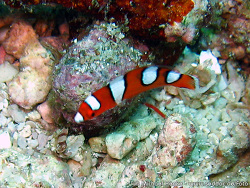Info
(Quoy & Gaimard, 1824)
The Yellowtail Coris can be recognised by its colouration. It is red to green with small bright blue spots on the body. The head is brownish with orange lines. The caudal fin is yellow. Large males have a green bar on the body above the anal fin origin.
Juveniles are red to orange with three black-edged white saddles on the back. There are two similar but smaller markings on the head.
Synonyms:
Coris gaimard gaimard (Quoy & Gaimard, 1824)
Coris gaimard speciosa (Fowler, 1946)
Coris greenoughii Günther, 1861
Coris greenovii (Bennett, 1828)
Coris pulcherrima Günther, 1862
Julis gaimard Quoy & Gaimard, 1824
Julis gaimard speciosa Fowler, 1946
Julis ganymede Bennett, 1830
Julis greenovii Bennett, 1828
Julis leucorhynchos Bleeker, 1856
Jumping guard
A jumping guard prevents (nocturnal) fish from jumping out.
Wrasses, blennies, hawkfishs and gobies jump out of an unprotected tank in fright if their night rest is disturbed, unfortunately these jumpers are found dried up in the morning on carpets, glass edges or later behind the tank.
https://www.korallenriff.de/en/article/1925_5_Jump_Protection_Solutions_for_Fish_in_the_Aquarium__5_Net_Covers.html
A small night light also helps, as it provides the fish with a means of orientation in the dark!
The Yellowtail Coris can be recognised by its colouration. It is red to green with small bright blue spots on the body. The head is brownish with orange lines. The caudal fin is yellow. Large males have a green bar on the body above the anal fin origin.
Juveniles are red to orange with three black-edged white saddles on the back. There are two similar but smaller markings on the head.
Synonyms:
Coris gaimard gaimard (Quoy & Gaimard, 1824)
Coris gaimard speciosa (Fowler, 1946)
Coris greenoughii Günther, 1861
Coris greenovii (Bennett, 1828)
Coris pulcherrima Günther, 1862
Julis gaimard Quoy & Gaimard, 1824
Julis gaimard speciosa Fowler, 1946
Julis ganymede Bennett, 1830
Julis greenovii Bennett, 1828
Julis leucorhynchos Bleeker, 1856
Jumping guard
A jumping guard prevents (nocturnal) fish from jumping out.
Wrasses, blennies, hawkfishs and gobies jump out of an unprotected tank in fright if their night rest is disturbed, unfortunately these jumpers are found dried up in the morning on carpets, glass edges or later behind the tank.
https://www.korallenriff.de/en/article/1925_5_Jump_Protection_Solutions_for_Fish_in_the_Aquarium__5_Net_Covers.html
A small night light also helps, as it provides the fish with a means of orientation in the dark!







 NikiWei
NikiWei

















































